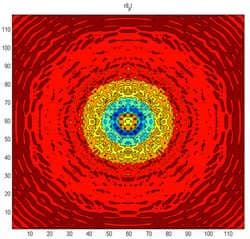What is the main difference between the Aires microprocessor and traditionally used microprocessors?
- any modern expert understands a processor first as a digital device with a von Neumann architecture, i.e. a device that unambiguously assumes the sequential execution of a program’s code;
- all information within the processor is written exclusively as rigorously defined levels of memory cell polarization, which means that an external power source is an absolute requirement;
- the processor is only a core that processes a previously created program, reading it command after command from the area of memory where the program’s code is stored and, if necessary, reading data to be processed, which was previously prepared in a form that the processor would understand. No processor can independently get data from its external environment – only through sensors and analog-to-digital converters or an input device.
Nanotech Microprocessor

Circular Diffraction
Lattices
C16
16 fractal vectors

C28
28 fractal vectors

C32
32 fractal vectors

The Aires microprocessor is a silicon wafer–in common use in the microelectronics industry–superimposed with a special fractal topology that satisfies the condition:

The circuit is created from rings using a special algorithm in the form of a self-affine matrix.

To understand how the neutralizer operates, we can take advantage of well-known concepts regarding a diffraction grating, which in the simplest case is a series of evenly-separated slits in a material that is opaque to radiation.
According to the Huygens-Fresnel principle, when parallel beams of energy hit a grating with spacing b, it produces diffraction, e.g. deviation from straight-line propagation of a stream close to obstructions, such as when an electromagnetic impulse passes through an opening or a slit. Moreover, the opening or slit becomes a source of secondary waves that propagate in all directions. Because these waves are caused by the same initial wave, they are coherent or, in other words, correlated.


Amplitude is on the left; phase is on the right.
If the slits are separated at some regular interval, then there will be regular superposition of the secondary waves, e.g. interference.
Interference causes a regular alternation of maximum and minimum intensity in the propagation of the secondary waves. The position (interval) of these extrema can be calculated using:

Because the greatest distance between maxima in the intersections of the microprocessor’s circular slits is approximately 5 µm, it works as a diffraction grating for the body’s thermal radiation, leading to interference and normalizing the radiation as it escapes.
The fractal matrix is a universal Fourier filter induces a space-time-, amplitude-frequency-, coherent transformation of electromagnetic radiation in a broad spectrum of frequencies.



The circuit’s number of axes of fractalization varies in different products from 8 to 24. A range in the number of processor cores is also available – from 1 to 24.
Each of the “8-ray” microprocessor’s cores consists of 1,594,323 circular modules, which are specially-shaped slits, 0.5 µm wide and 1 µm deep, in the silicon wafer. Of course, the latest 24-core microprocessor, which is only used in the V.I.P. series, has roughly 40 million.
This type of slit creates a phase shift in the surface wave and acts as a high-frequency waveguide for two colliding functions.


When the intensity of an energy stream moving along a ring reaches the threshold value, an opposing soliton is generated. As only the phases of these wave functions coincide, a stable, stationary field is created in the form of a spatial fractal structure, usually referred to as a hologram. It should be noted that within each circular segment of the circuit is a radial oscillation (center-periphery-center) in the form of radially compressing and expanding waves with a stable spectrogram. In lenticular areas of the intersection of the circular waveguides, a linearly-dashed spectrogram occurs, which is also oriented against the process’s optical axis, promoting interference with a broad range of external electromagnetic fields.
Significantly, the incoming high-amplitude energy stream’s local points of concentration in now way change the structure of the field, nor its cumulative spectrogram, indicating the extreme stability of this wave formation, which can redistribute energy through the entire system with great efficiency, without losing the existing spectral properties embodied in a large number of nested, spherical surfaces that share a single phase center with all of the wave formations.
The central area of the circuit is the most neutral. As a result, a potential difference arises between the periphery and the center. Consequently, a voltage is induced that activates the microprocessor.


Thus, the Aires microprocessor has no need for a special energy source. It draws power from external radiation. A wave impulse striking any part of the circuit is discharged to its center and automatically redistributed throughout the entire circuit through slits’ channels. Consequently, the field’s intensity is simultaneously distributed about any radius, except in the center where, due to the density of the circuit, it reaches its maximum value, while its polarization is at a minimum.
Owing to the potential difference between the center and the periphery, the charges flow from the periphery to the center. Circular surface waves occur, which also induce derivative superpositions. Where the slits intersect, the phases shift and a space-time structure in the form of a hologram is created, which has the same properties: a space-time-, amplitude-frequency-, coherent transformation of radiation with a broad frequency range and the microprocessor’s regular fractal circuitry to induce the transformation. Moreover, due to the properties of electromagnetic radiation (interference and coherence), this field reflex (hologram) is enhanced even more on the scale of the fractal matrix that generated it. The hologram turns into a spatially-extended “crystal” that can efficiently transform virtually any electromagnetic field of a diverse range and character that interacts with it into a coherent state, becoming a universal space-time-, amplitude-frequency-, coherent transformation. Up to 30% of the circuit can be destroyed without affecting its superposition.
The operating range of such a coherent transformer depends on the number of axes of fractalization, while the quality of the coherence depends on the density of its structural composition. A diagram of the interaction is radially spherical. During the experimental approval process, a memory phenomenon was observed in the electromagnetic radiation generated by objects. After prolonged contact with the Aires microprocessor, there was a rearrangement of the polarization structure of the objects’ crystalline domains. As a result, the object continued to radiate a coherently-transformed field even without direct contact with the Aires microprocessor.
Thus, without any need for a special energy source, the Aires microprocessor can use incident radiation to create its own wave superposition in the form of a space-time fractal “crystal” that can efficiently transform electromagnetic radiation it interacts with of various behavior, character, and intensity into a coherent state.
This phenomenon opens the door to the future creation of fundamentally new, previously unheard of technical devices, capable of substantially changing the nature of the manufacturing process, making it both environmentally friendly and entirely safe for humans. The Aires microprocessor is protected by several patents.
